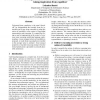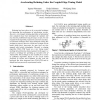INFOCOM
2012
IEEE
11 years 6 months ago
2012
IEEE
—Cognitive Radio Networks allow unlicensed users to opportunistically access the licensed spectrum without causing disruptive interference to the primary users (PUs). One of the ...
ISAAC
2010
Springer
13 years 2 months ago
2010
Springer
We study polynomial time complexity of type 2 functionals. For that purpose, we introduce a first order functional stream language. We give criteria, named well-founded, on such pr...
IJCAI
1993
13 years 5 months ago
1993
Polynomial time complexity is the usual ‘threshold’ for distinguishing the tractable from the intractable and it may seem reasonable to adopt this notion of tractability in th...
ISVLSI
2002
IEEE
13 years 9 months ago
2002
IEEE
Retiming has been shown to be a powerful technique for improving the performance of synchronous circuits. However, even though retiming algorithms of polynomial time complexity ha...
WG
2005
Springer
13 years 9 months ago
2005
Springer
In this paper, we consider the recognition problem on the HHDS-free graphs, a class of homogeneously orderable graphs, and we show that it has polynomial time complexity. In partic...
MFCS
2005
Springer
13 years 9 months ago
2005
Springer
Abstract. Feige and Kilian [5] showed that finding reasonable approximative solutions to the coloring problem on graphs is hard. This motivates the quest for algorithms that eithe...


